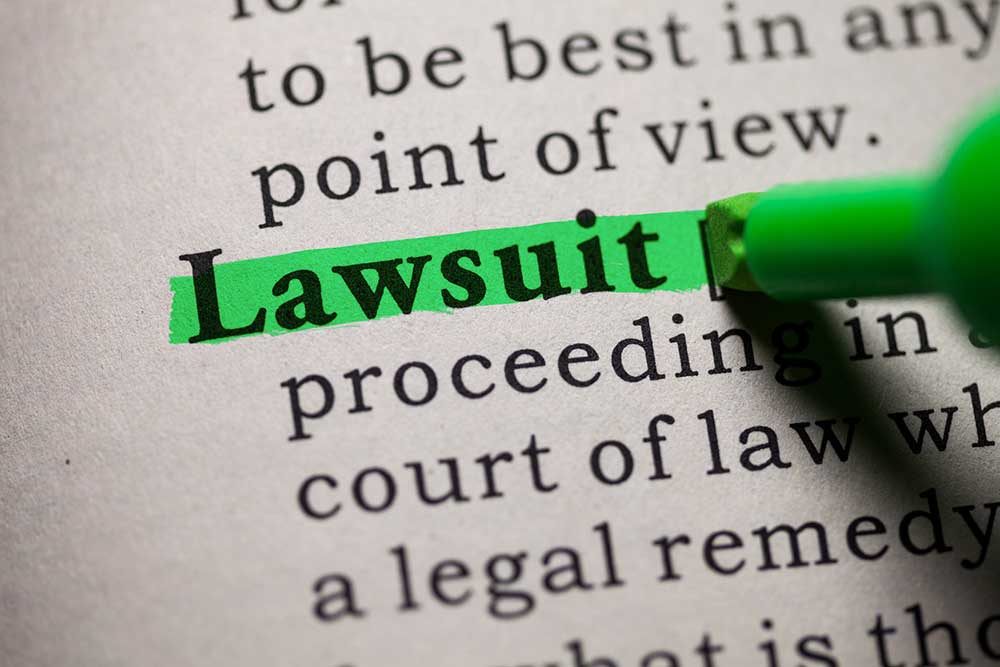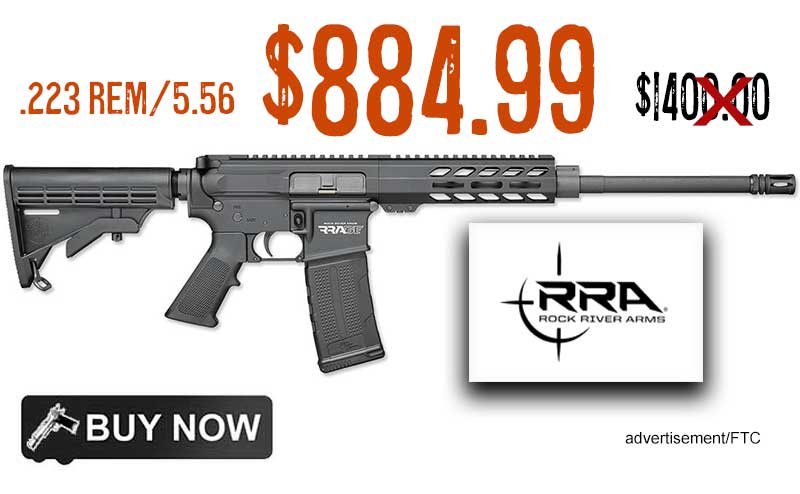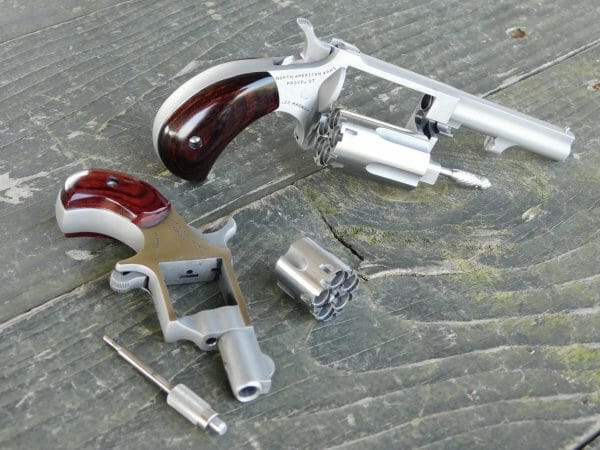
We all have guilty pleasures, right? There are plenty of things I like that I am somewhat apologetic for liking. Adam Sandler movies pop up in my head. Sure, the formula is tiring but you might find me in the theater watching a Happy Madison production. When it comes to guns, my guilty pleasure has to be 22-caliber defensive handguns.
I know some of you are thinking 22 caliber and defensive should not be in the same sentence. To be clear, the 22 LR and 22 Magnum cartridges are rimfire rifle cartridges that lose a lot of their potential when put into pistols–especially tiny pistols. The power level is low, and rimfire ignition can leave something to be desired. These rounds were never intended to be put into pistols yet somehow here we are. What we get in exchange is a handgun that is made smaller and lighter than other major caliber offerings like 380 ACP or 9mm Luger.
Convenience is the name of the game for most people who wish to carry a pistol for personal defense, and sometimes the situation dictates a very small gun when a more capable one has to be left at home. I find this class of pistol absolutely fascinating. There are a few excellent snub-nosed revolvers like Smith & Wesson’s Model 43c and well-made semi-autos like the Beretta Bobcat. But perhaps the most prevalent of pocket 22s today are North American Arms’ Mini Revolvers. I have quite a collection of these little five-shooters. My most recent acquisition is the underreported NAA Sidewinder in 22 Magnum.
North American Arms Sidewinder 22LR/22 Magnum
The NAA Sidewinder has been out for a few years but there isn’t much information out about this revolver. Unlike the standard NAA Minis, the Sidewinder does not need to be disassembled to load or unload.
The Sidewinder uses a swing-out cylinder and ejector rod like those found on bigger revolvers. It differs from the usual NAA design, which requires the cylinder pin to be pulled from the pistol and the cylinder rolled out for loading. But it seems NAA lovers have been heaping more praise on the recent return of the Ranger II.
Truth be told, I like the way the Sidewinder looks and operates. After months of internal struggle, I purchased one. My pistol has a longer 2.5-inch barrel and the optional 22 LR conversion cylinder. It came in the usual padded steel lockbox that NAA now ships with its guns.


On the first inspection, the Sidewinder failed to impress. The pistol is all stainless steel and comes equipped with a pair of rosewood bird’s head grips. The grips are nice and the machining is well done but I was not the fan of some metal parts being left in a matte finish while other parts like the frame and cylinder were polished up. I would have preferred that the pistol be entirely matte or entirely polished.
Like any NAA Mini, the Sidewinder is a single-action revolver, requiring the hammer to be cocked for each shot and the small spur trigger fires the gun. The cylinder holds five rounds of 22 Magnum ammunition and is milled with inter-chamber safety notches so that the hammer can be rested between chambers so as not to have the hammer down on a live round. Getting the cylinder out is accomplished by pulling the knurled end of the ejector rod and swinging the cylinder out and to the right. There is no cylinder latch on the frame that may be used like on a conventional revolver. Empties are pushed out by the extractor star when the rod is hit with a finger.




Another fine point about the Sidewinder is that the recoil shield is dovetailed to the frame and not an integral casting with the frame. It is also worth noting that the 22 LR conversion cylinder and the 22 Magnum cylinder have no distinctive markings differentiating one from the other. I had to drop rounds into the cylinder to figure out which was which. Needless to say, we are off to a great start…
On The Range
The real reason for my buying the Sidewinder was not just a justification for another NAA but as a test platform to spot the differences between the 22 LR and the 22 Magnum. Needless to say, I had a ton (okay, not quite 2,000 pounds) of ammo to run through the Sidewinder. After a quick cleaning I set out for the range.
I could see the convenience of the Sidewinder from the very first go-around. Loading is accomplished by half-cocking the cylinder, pulling the ejector rod forward, and then swinging the cylinder out. They cylinder rotates to the right, which is great for a lefty like me. I can use my weak hand to load the pistol while my strong hand retains a semblance of a firing grip on the gun. For right-handed shooters, it would mean a hand change so your strong hand will be free to load. Either way, it is much easier than removing pieces of the gun just to load it. I dropped five 22 Magnum shells into the chambers and closed the cylinder.
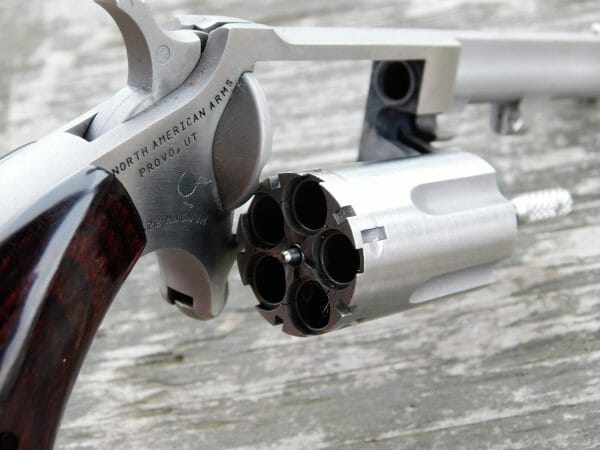

I started out by shooting the Sidewinder on an eight-inch steel plate at ten yards. I started out with some Federal Gameshok 50 grain hollow-points–the heaviest readily available 22 Magnum loading. I took the pistol into a relatively awkward two-handed hold, cocked the tiny hammer, put the bead on the center of the plate, and then I let fly.
My first few misses zoomed over the target, so I had to aim at the foot of the plate to hit dead center. My five rounds went quickly, and I continued retreating from the Texas summer heat to lather myself in sunscreen and reload. After breaking open the gun, I hit the ejector rod, and the empty cases were extracted out. Those long Magnum cases are not going to be fully ejected most of the time so I had to pull a few out with my fingers. I switched up brands to CCI 40 grain FMJ. This solid bullet is my choice for 22 Magnum defensive use and it sailed somewhat high when holding the bead at the bottom of the target, but close enough to hit the top of the target, five for five. Things got better when I tried out some CCI 30-grain HP+V ammunition. This high-velocity varmint load shot right to the point of aim from the get-go.
Satisfied that the Sidewinder’s point of impact would vary according to the weight of loading, I decided to enjoy myself by switching to the 22 LR conversion cylinder. The change is accomplished by unfastening the screw that retains the crane of the cylinder. The Magnum cylinder fell out, and the 22 LR cylinder came out with ease. Replace and retighten the screw, and you are ready to fire for some cheap practice.
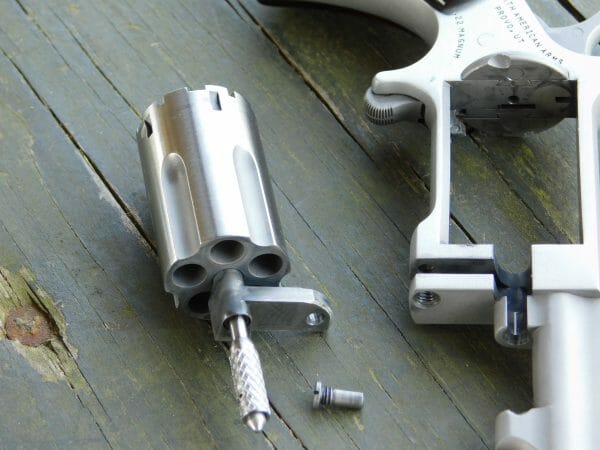

The variety of 22 LR cartridges is even more numerous than the venerable 22 Magnum, and ultimately, I ended up doing half of my four-hundred-round battery of tests with the 22 LR cylinder in place. I used my standby bulk pack ammunition, Winchester Western 36-grain hollow-points combined with a mix of CCI Copper 21-grain solids, CCI Mini Mag 40-grain solids, CCI Blaser 40-grain lead, and CCI 30-grain Stingers.
Though the 22 LR is a shorter and less powerful cartridge, recoil was about the same as the 22 Magnum. When fired, a tenacious fireball erupts from the pistol and the barrel pulls high into the air, slipping my grip momentarily before settling back down to be re-cocked for the next shot. The pistol is jumpy but it never felt uncomfortable to shoot.
Recoil was stout, but I certainly never felt it. Nor was the gun so small that I got powder burns on my hands like with the NAA 22 Short that accompanied me to the range once again. Speaking of shorts, I fired a few CCI 22 Short rounds out of the Sidewinder. Recoil and report were very low. So low I could hear the bullets ricocheting off the fifty-yard berm, but I had a few instances where the Shorts failed to fire. They had been stored in high humidity for months and it was to be expected. What was not expect was the single misfire I experienced while using 22 Magnum Speer Gold Dot defensive ammunition. It goes to show that any ammo can fail, especially in rimfire cartridges, and it is important to not only store your ammunition in a cool dry place and test your ammunition before committing it for serious use.
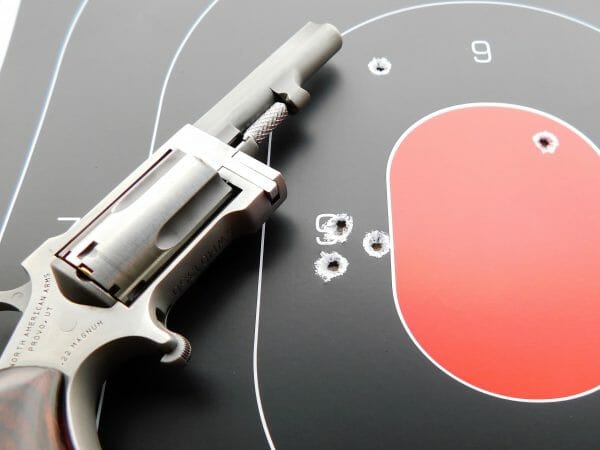

I burned through quite a few 22 LR rounds but when going after that steel plate, even out to fifteen yards, all ammunition hit to the point of aim in the center of that steel plate while the Magnum loads shot a bit high. The swing-out cylinder looks quite small and fragile compared to bigger guns, but it generally acquitted itself well in the constant loading and unloading I was doing, but I did notice that the revolver’s cylinder did not fully index and lock into the frame unless that ejector rod was pulled forward again and rolled into place until it locks. It was not as instinctive as the rod springing forward automatically and shutting up just right like on a normal double-action revolver. The cylinder has to be rolled out all the way so that all the cases extract cleanly, but even so ejection started getting sticky toward the end of my test–a sign of a very dirty gun.
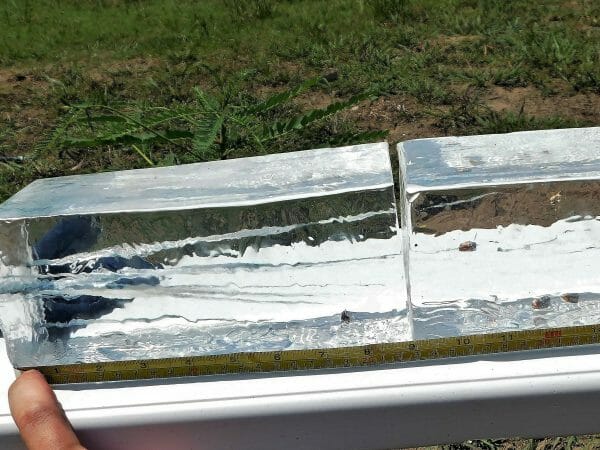

The Sidewinder is running 22 LR ammunition at about 200 feet per second slower than the 22 Magnum, even so the 22 LR is nasty. While the light CCI Copper and Stinger rounds did not penetrate well, the 40 grain Mini Mags at the 12-13 inch mark did well. Not something to shoot through auto-glass, but not something I would want to face either.
Carrying The Sidewinder
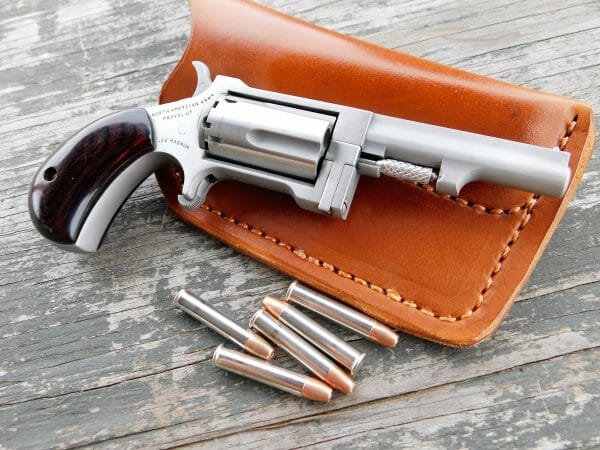

The Sidewinder’s standard model comes equipped with a 1.5-inch barrel, but mine came with a 2.5-inch barrel. Even so, with full loads, the Sidewinder weighs in at only 7.6 ounces. That is lighter than any micro 380 on the market and that 2.5-inch barrel is going to squeeze out the extra juice from those 22 caliber cartridges. But that longer barrel made for a problem when hunting for a holster. There is some support from NAA and other manufacturers for the standard model, but I ultimately went to Etsy to find a good leather holster for pocket carry. I realized that the shorter barreled version may be best for pocket carry but the 2.5 inches still hid well in my usual wardrobe–gray jogging pants and matching t-shirts.
Live Inventory Price Checker
Final Thoughts
As is the pattern when I finish up a review, I was left with a very dirty gun and a few fine points to ponder. I am generally harsh on NAA Mini revolvers. There is usually some minor detail that throws water on the flaming optimism I exhibit whenever I bring out a new gun to test. I did find myself still wishing I had the standard 1.5-inch barreled model. There are many more holster options for that model and the inclusion of a 22 LR cylinder is nice but of dubious value to me beyond ballistic testing. 22 Magnum ammunition is still going to cost less than larger caliber rounds and there is no recoil difference between the two rounds to warrant having that conversion cylinder.
With that said, the usual weak points of NAA Minis still hold true. It is a small gun to hold and can be slow to fire in a hurry, but with some practice you can work the gun pretty fast with some accuracy to boot. That accuracy was definitely helped by the small bead front sight. Sure it is small, but it is far better than the half-moon found on a standard Mini. The swing-out cylinder may never be as natural as on a big revolver but it worked pretty well for being in miniature. Would it make a difference in a fight? Probably not, but the Sidewinder is faster to reload, safer in doing so, and you aren’t risking the loss of small pieces.
Quirks aside, I believe the NAA-SW is NAA’s best product so far and one that deserves some recognition.
About Terril Hebert:
Terril Hebert is a firearm writer native to south Louisiana. Under his motto-Guns, Never Politics-he tackles firearm and reloading topics both in print and on his Mark3smle YouTube channel, where he got his start. Terril has a soft spot for ballistics testing, pocket pistols, and French rifles. When he is not burning ammo, he is indulging his unhealthy wildlife photography obsession or working on his latest novel. Scourge of God, published in 2017. See more from Terril on youtube under Mark3smle

